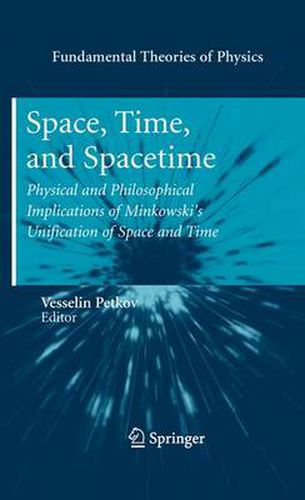Readings Newsletter
Become a Readings Member to make your shopping experience even easier.
Sign in or sign up for free!
You’re not far away from qualifying for FREE standard shipping within Australia
You’ve qualified for FREE standard shipping within Australia
The cart is loading…






This title is printed to order. This book may have been self-published. If so, we cannot guarantee the quality of the content. In the main most books will have gone through the editing process however some may not. We therefore suggest that you be aware of this before ordering this book. If in doubt check either the author or publisher’s details as we are unable to accept any returns unless they are faulty. Please contact us if you have any questions.
In 1908 Hermann Minkowski gave the four-dimensional(spacetime) formulationof special relativity[1]. In fact,HenriPoincare[‘ 2] rst noticedin1906that the Lorentz transformations had a geometric interpretation as rotations in a four-dimensional space with time as the fourth dimension. However it was Minkowski, who succe- fully decoded the profound message about the dimensionality of the world hidden in the relativity postulate, which re ects the experimental fact that natural laws are the same in all inertial reference frames. Unlike Poincare, ’ Minkowski did not regardspacetime - the uni cation of space and time - as a convenientmathematical space, but insisted that this absolute four-dimensional world, as Minkowski called it, represents physical phenomena and the world more adequately than the relativity postulate: the word relativity-postulate…seems to me very feeble. Since the pos- late comes to mean that only the four-dimensional world in space and time is given by the phenomena…I prefer to call it the postulate of the absolute world [3]. The impact of Minkowski’s ideas on the twentieth century physics has been so immense that one cannot imagine modern physics without the notion of spacetime. It would hardly be an exaggeration to say that spacetime has been the greatest discoveryinphysicsofall times. Theonlyotherdiscoverythatcomesclosetospa- time is Einstein’s general relativity, which revealed that gravity is a manifestation of the curvature of spacetime. But it was the discovery of spacetime, which paved the way for this deep understanding of what gravity really is. Einstein saw the link betweenthegeometryofspacetimeandgravitationonlyafterheovercamehis initial hostile attitude toward the notion of spacetime.
$9.00 standard shipping within Australia
FREE standard shipping within Australia for orders over $100.00
Express & International shipping calculated at checkout
This title is printed to order. This book may have been self-published. If so, we cannot guarantee the quality of the content. In the main most books will have gone through the editing process however some may not. We therefore suggest that you be aware of this before ordering this book. If in doubt check either the author or publisher’s details as we are unable to accept any returns unless they are faulty. Please contact us if you have any questions.
In 1908 Hermann Minkowski gave the four-dimensional(spacetime) formulationof special relativity[1]. In fact,HenriPoincare[‘ 2] rst noticedin1906that the Lorentz transformations had a geometric interpretation as rotations in a four-dimensional space with time as the fourth dimension. However it was Minkowski, who succe- fully decoded the profound message about the dimensionality of the world hidden in the relativity postulate, which re ects the experimental fact that natural laws are the same in all inertial reference frames. Unlike Poincare, ’ Minkowski did not regardspacetime - the uni cation of space and time - as a convenientmathematical space, but insisted that this absolute four-dimensional world, as Minkowski called it, represents physical phenomena and the world more adequately than the relativity postulate: the word relativity-postulate…seems to me very feeble. Since the pos- late comes to mean that only the four-dimensional world in space and time is given by the phenomena…I prefer to call it the postulate of the absolute world [3]. The impact of Minkowski’s ideas on the twentieth century physics has been so immense that one cannot imagine modern physics without the notion of spacetime. It would hardly be an exaggeration to say that spacetime has been the greatest discoveryinphysicsofall times. Theonlyotherdiscoverythatcomesclosetospa- time is Einstein’s general relativity, which revealed that gravity is a manifestation of the curvature of spacetime. But it was the discovery of spacetime, which paved the way for this deep understanding of what gravity really is. Einstein saw the link betweenthegeometryofspacetimeandgravitationonlyafterheovercamehis initial hostile attitude toward the notion of spacetime.